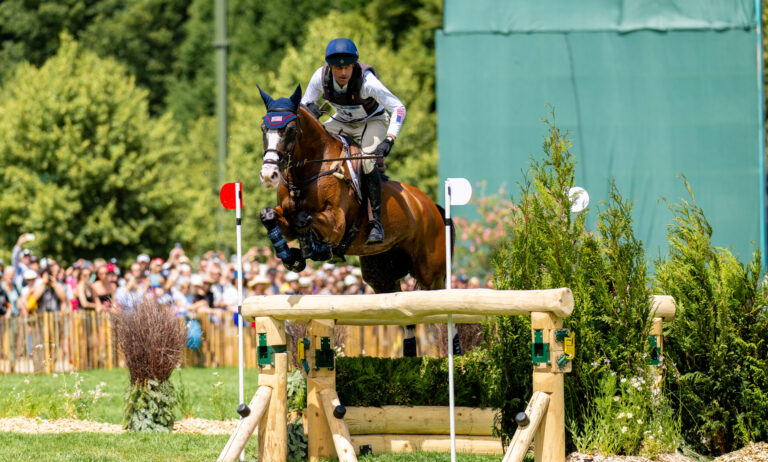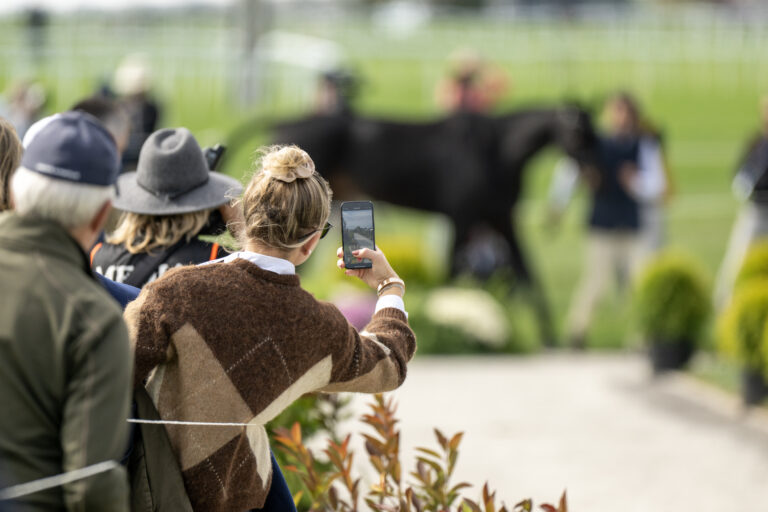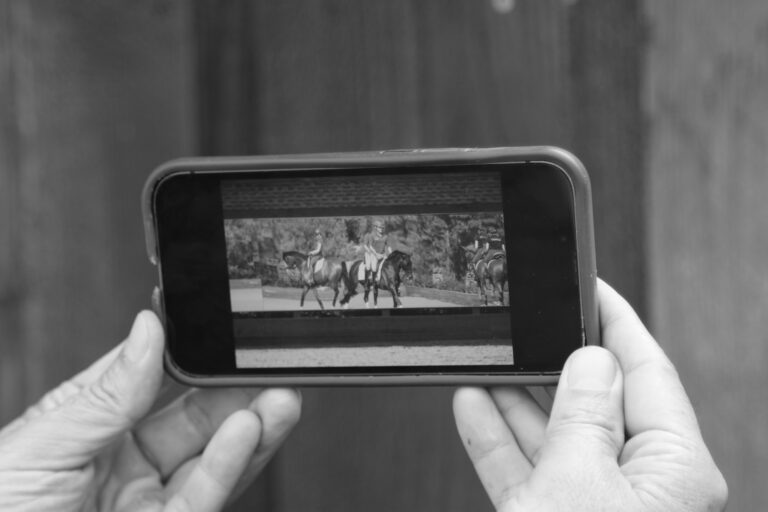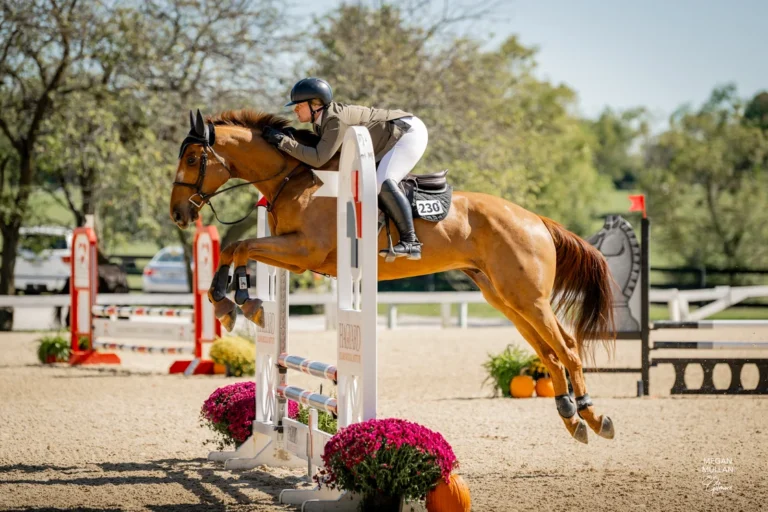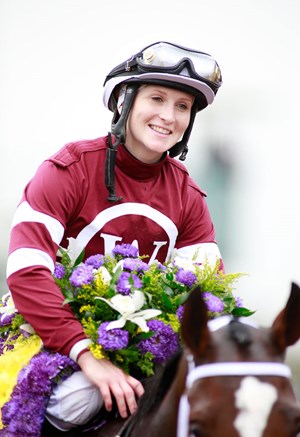
© Breeders’ Cup Photo
Most are used to seeing jockey Rosie Napravnik flying down the racetrack in the lead of some of the country’s biggest races, but on this night in 2014 she traded in her colorful silks and tiny racing saddle for boots, breeches and a jumping saddle. Riding a former racehorse known as Sugar, Rosie warmed up on the flat, starting him out long and low and incorporating circles and serpentines as he became more relaxed. She then cantered figure eights with seemingly effortless changes from one lead to the other and eventually schooled him over a small course of 3-foot-6 fences.
With a wireless microphone affixed to her helmet, Rosie explained to the more than 600 spectators how she retrained Sugar from the strong gelding she’d struggled to contain in his morning gallops to the supple and fluid eventer who could easily hold his own in the hunter ring as well.
The demonstration was part of the annual Thoroughbreds For All event put on by New Vocations and the Retired Racehorse Project during the week of the Rolex Kentucky Three-Day Event. Sugar, who ran as Old Ironsides mostly in lower-level claiming races on the East Coast, is now Rosie’s personal riding horse and has also been used by her husband, racehorse trainer Joe Sharp, as a stable pony at the track. The pair showed Sugar’s versatility to the crowd with Joe first riding Sugar into the open-air arena in Western tack while Rosie discussed the typical daily routine and responsibilities of a track pony. Then the couple swapped the Western tack for English, and Rosie showed off what the gelding has learned away from the races.
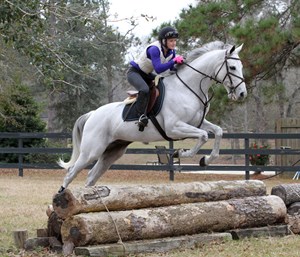
© Lynn Roberts
The event was just one of the ways Rosie, who retired from racing last fall, has worked to promote the Thoroughbreds she loves, especially in second careers as sporthorses. Now 27, Rosie currently sits on the boards of several Thoroughbred aftercare organizations, including Old Friends and the Retired Racehorse Project, and can be found most mornings assisting Joe in his racetrack shedrow or escorting racehorses to the track aboard Sugar. “I try to support as many Thoroughbred aftercare and adoption organizations as I can,” she says. “Thoroughbreds have given me nearly everything I have.”
Ride Like a Girl
In a sport dominated by men, the 5-foot-2 Rosie, with a sweet face and calm demeanor, was a fierce competitor since her first race—literally. Since then she’s earned her status as one of the world’s most successful jockeys with a list of firsts and bests that rivals the most decorated race riders in history.
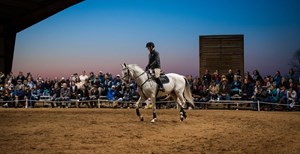
© Megan Stapley Photography
Growing up in New Jersey, Rosie was born into the horse industry. Her mother, Cindy, an accomplished eventing rider and trainer, put her two daughters on the backs of horses at an early age. Both girls were involved with their local Pony Club chapter and showed regularly from the ages of 3 or 4 onward. “I evented up to Training level until I was about 12 years old, but I didn’t want to spend time learning how to do things properly. I just wanted to get on and go,” says Rosie. “As long as I had steering and brakes, I was good.” Six years Rosie’s senior, her sister, Jazz, eventually gravitated more toward faster-paced events such as pony racing, and before long Rosie followed suit.
The Napravniks traveled around the East Coast to compete in pony races, which were held at steeplechase meets, and eventually Rosie graduated to riding the junior horse circuit. Her experiences riding at steeplechase meets also led her to exercising horses for world-renowned trainers Jonathan Sheppard and Dickie Small. When she turned 16 in 2004, Rosie took out a license with the National Steeplechase Association and rode training flat races during the steeplechase meets against experienced riders.
That summer she lived with trainer Holly Robinson, whom her sister was working for as an assistant, to begin galloping horses at the racetrack in the mornings. With the encouragement of Holly, Dickie and others, Rosie applied for her jockey’s license when she turned 17.
On June 9, 2005, she was legged up for her first official race, and she and her mount, a bay 4-year-old filly named Ringofdiamonds, came home two lengths ahead of their closest rival. Rosie’s career was off and running.
Making Her Mark On Racing History
Since that first win, Rosie has become a racing sensation. In 2012 she broke the single-year earnings record for a woman jockey previously set by Julie Krone. That year she also became only the second female rider to win a Breeders’ Cup race, guiding Shanghai Bobby home to their fifth victory together that year in the Breeders’ Cup Juvenile to remain undefeated and later to be named that year’s Champion Two-Year-Old Colt. That same year she also became the first female rider to win the Kentucky Oaks, when she piloted Believe You Can to victory in the Run for the Lilies.
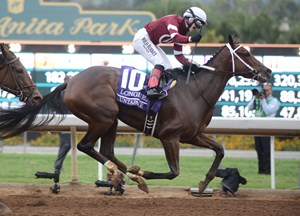
© Breeders’ Cup Photo
In 2013 Rosie became the first female jockey to compete in all three jewels of the Triple Crown, riding Mylute to a fifth-place finish in the Kentucky Derby and third in the Preakness Stakes and Unlimited Budget to a sixth-place finish in the Belmont Stakes. In 2014 she guided the filly Untapable to six graded stakes wins, including victories in the Kentucky Oaks and the Breeders’ Cup Distaff, becoming the first female rider to win multiple editions of the Oaks and the first female rider to win multiple Breeders’ Cup races. The Breeders’ Cup win clinched year-end champion honors for Untapable and, during the post-race interview, Rosie announced that she and Joe were expecting their first child and that she would be retiring after that weekend.
Rosie’s success over the years brought her not only more and more riding opportunities for some of the biggest names in racing, but it has also garnered her throngs of young fans hoping to one day emulate the style and ability of their role model. “Social media really allows me to connect with people, whether it’s a 5-year-old who wants to be a jockey or parents who say their son or daughter wants to be just like you when they grow up,” she says. “Fans come up to me and hand me artwork, letters, pictures of them riding—it’s really amazing and heartwarming. It inspires me to build on my accomplishments and to be that role model they can look up to and that their parents would want them to look up to.”
Riding Off the Track
Just like many of her young fans, Rosie’s interest in horses is rooted deeply in the world of riding and showing, and much of her experiences growing up in the show ring, on the cross-country course and around the steeplechase ovals came on the backs of Thoroughbreds.
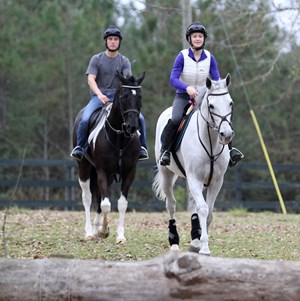
© Lynn Roberts
Sugar, for instance, was definitely not the most accomplished horse Rosie has ever ridden, but he was and still is her favorite, which is how he landed in her hands once his racing career ended. “I fell in love with Sugar the first time I sat on him,” she says. “He’d had injuries in the past—a condylar fracture in front and one in the back—but he has so much class. He was strong and would really challenge me in the mornings to get him around at the right speed. He was a real racehorse.”
Upon his retirement from racing, Sugar was sent to Rosie’s mother’s farm to be turned out and reschooled. He was eventually used in lessons by some of the more advanced riders. Rosie would visit the farm one to two times a week to see her family and ride Sugar, and when the time came for Rosie to move to Louisiana for the winter meet, she decided to bring Sugar with her for Joe to use as a stable pony to escort racehorses to and from their morning workouts.
“My mom did a great job retraining Sugar. I would take him trail riding or for a hack around whenever I could find the time,” Rosie says. “About a year and a half ago my friend Anna Roberts, who is also a jockey and also has an off-track Thoroughbred, asked if I wanted to go cross-country schooling at a place about an hour from the track. That was the first time I really thought ‘I miss this so much,’ so I got my tack back from my mom and started doing that as much as I could.”
Like most young up-and-coming jockeys, Rosie galloped and breezed horses in the mornings and rode races in the afternoons five to six days a week. That grueling schedule left little time for training Sugar to be an eventer, but she learned to fit schooling sessions in where she could. Last May, after the Kentucky Derby was behind her, she decided to board Sugar at a stable near her house so she could spend more time schooling him in an arena.
“We finally made it to our first event on July 13 of last year and we finished fifth overall,” Rosie says. “We had a blast. The summer is so busy with big races every weekend, but I could find a Sunday here and there when I had no mounts in stakes races and I could go compete with Sugar. The last week of July I happened to have a Friday with no mounts, so I started looking around for a show to take Sugar to and found a hunter/jumper show with a few classes we could do that day. I just had to fit it in where I could.”
Racetrack Retirement Is Just the Beginning
“Racehorses are exposed to so many things, and I think that helps them tremendously in their second careers,” Rosie explains. “They’re always moving and changing scenery and being asked to perform in different places. Claiming horses like Sugar I find are especially adaptable to change. Many times they switch from one trainer to another, and each trainer has his or her own routine and way of doing things. I think it helps them go into reschooling with such a good attitude and makes them so adaptable to new situations, experiences and surroundings.”
Having a background with Thoroughbreds both on and off the racetrack has given Rosie a unique and thoroughly informed understanding of how best to acclimate a former racehorse to a new career. She says the process of “letting a horse down” is key to him becoming well-adjusted in his off-track life both mentally and physically, and using a mix of chiropractic, acupuncture and massage therapy can dramatically help a horse excel in his initial reschooling.
“I know a lot of people on the racetrack aren’t big on chiro or massage therapy for horses, but I know from my personal experiences as an athlete that when I get a chiropractic adjustment and follow it up with a massage it is tremendously effective,” Rosie says.
Utilizing chiropractic and massage therapy on a horse can often help a rider negotiate some of the most common training challenges associated with off-track Thoroughbreds. Using Sugar as an example, Rosie explains that the right combination of alternative treatments can often help to overcome a former racehorse’s typical issues with dexterity, suppleness and flexibility.
“One of the biggest challenges in retraining a horse is gaining strength and balance,” Rosie says. “You wouldn’t think that of a fit racehorse, but at the track they are only asked to go forward but never asked to collect or balance themselves. Sugar’s back was nearly 6 inches out of alignment when I got him. He’d be so tired from cantering one 20-meter circle properly, and like most former racehorses he was very left-handed. Chiro and massage have made a huge difference in how he moves and bends.
“Once they start being able to use themselves properly, you can work on teaching them to go long and low,” Rosie continues. “I typically ride Sugar long and low for 10 minutes at the beginning of every schooling session. It takes them a while to learn how to do that and how good it feels through their neck and back.”
Recycling Racehorses
With such a strong passion for repurposing retired racehorses as riding and show horses, Rosie explains that she is often tempted when she sees a horse with little potential as a racehorse but significant potential for some other discipline. “Just about every Thoroughbred loves to run; however, sometimes I see a horse with so much potential on the track, but they are slow or uninterested in racing or understimulated at the racetrack doing the same thing around the same circle every day,” she says. “They hold no value as a racehorse if they’re not winning races, but they hold heaps of value doing something else. Sometimes it’s such a tease for me to see what they are versus what they could be doing something different.”
That perspective is the catalyst for her involvement with Thoroughbred aftercare organizations, and with her newfound flexible schedule, Rosie plans to do more on behalf of Thoroughbreds retiring from racing in her own retirement from the sport. “Thoroughbreds made me the rider I am. They brought me tremendous success in my career, and they even led me to my husband. I want to support them with everything I have to give.”
This article originally appeared in the April 2015 issue of Practical Horseman.





